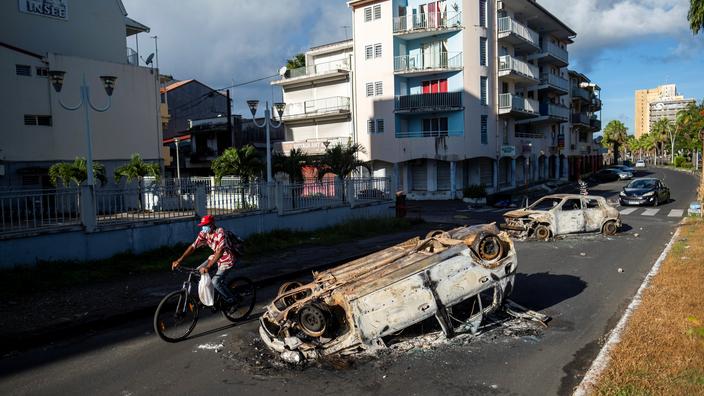For a week, Guadeloupe has been on fire.
While hundreds of suspensions were pronounced at the University Hospital of Pointe-à-Pitre, as part of the vaccine obligation against Covid-19, the general strike launched Monday, November 15 by a collective of unions is maintained in Overseas .
The situation quickly deteriorated, going from highway blockades to looting and numerous clashes between strikers and the police.
Faced with this urban violence, the government sent on Sunday, November 21, around fifty agents from the GIGN and the mainland RAID as reinforcements.
Why has this mobilization deteriorated rapidly and what is the government doing to stop it?
Le Figaro
takes stock.
Read alsoAfter a weekend of violence, Guadeloupe on the verge of conflagration
What is the situation in Guadeloupe?
Since this summer, the vaccination rate has increased in Guadeloupe, with nearly 50% of the population over the age of 18 having received at least one dose of the vaccine.
While 87% of health workers are vaccinated, the remaining 13% have seen their posts suspended.
As a result, firefighters and health workers, quickly joined by teachers, hotel and restaurant professionals, launched a strike to oppose these measures.
Dams have been set up all over the island and clashes were noted at the start of the week between the police and the strikers.
On Monday, two firefighters were injured.
Sportswear store owner talks on his cell phone as he inspects damage to his business after it was looted, after violent protests erupted against coronavirus disease (COVID-19) protocols , in Pointe-à-Pitre, Guadeloupe, on November 21, 2021. RICARDO ARDUENGO / REUTERS
But the situation quickly degenerated: fires, looting, threatened caregivers, pharmacies and food stores vandalized, police officers targeted by shots ... The island was plunged into a context of "
urban guerrilla
", as evoked by the firefighters, forcing the prefect to institute a curfew from 6 p.m. to 6 a.m. last Friday.
In the night from Saturday to Sunday alone, 38 people were arrested by the police.
SEE ALSO -
In Guadeloupe, significant damage after demonstrations against the health pass
To cope with this violence, the government sent on Sunday, November 21 a staff of 200 additional agents from the metropolitan area, including 50 members of the GIGN and Raid units.
This Monday, the rectorate suspended the reception of students in schools, colleges and high school, and 30 people, suspected of having participated in urban violence, are on trial in immediate appearance in Pointe-à-Pitre.
Who called for a general strike?
The call for a general strike was launched under the aegis of the General Union of Workers of Guadeloupe.
Following the suspension of health workers who were not vaccinated, the collective of union and citizen organizations called for a mobilization to protest against the law of August 5.
Activists from the General Union of Workers of Guadeloupe UGTG roll tires as they set up a blockade at the Perrin Les Abymes roundabout, in the French Antilles archipelago of Guadeloupe, November 17, 2021. - Des Union activists The UGTG union of the general workers of Guadeloupe called for a strike against compulsory vaccination on November 15, 2021. CARLA BERNHARDT / AFP
The mobilization quickly evolved and now brought together many young people angry about the situation in Guadeloupe.
According to the secretary general of the UGTG, the vaccine obligation was "
the straw that broke the camel's back
", the movement also reflects the "
depth of suffering, inequalities, poverty and poverty. exclusion suffered by the population ”
.
How many caregivers have been suspended?
According to the Pointe-à-Pitre University Hospital, 566 suspensions have already been pronounced, while the rate of compliance with the vaccination obligation of caregivers is 87%.
The firefighters are also strongly mobilized, a minimum service has been organized, to allow the striking agent to exercise his right to strike while the departmental fire and rescue service continues to preserve the health of fellow citizens in Guadeloupe.
How is the government reacting?
This weekend, 2,250 police and gendarmes were present on the territory, to which is added the number of 200 agents sent from metropolitan France. For government spokesperson Gabriel Attal, the situation is "
intolerable and unacceptable
". Traveling this Monday, November 22 in Amiens, the President of the Republic Emmanuel Macron, for his part, judged the situation as "
very explosive
". According to him, these are events linked "
to a very local context, to tensions that we know and which are historical, and also to certain interests which seek a little to use this context and anxiety
" .
Guadeloupe riot police stand guard in a street after French police reinforcements have been sent due to violent protests that have erupted against coronavirus disease (COVID-19) protocols, in Pointe-à-Pitre, Guadeloupe, November 20, 2021. Photo taken November 20, 2021. RICARDO ARDUENGO / REUTERS
The tenant of the Élysée recommends a simple method to solve the problem: “
Explain, explain, explain.
Convince, convince, convince.
"After seven days of blockage, Prime Minister Jean Castex, accompanied by Minister of Overseas Territories Sébastien Lecornu and Minister of Health Olivier Véran, must receive on Monday evening elected officials from the island in order to allow them"
to expose their analysis of the situation on the spot
”.
What had happened in 2009?
This is not the first time that Guadeloupe has faced this type of movement.
Twelve years ago, at the end of January 2009, a general strike began in Guadeloupe before spreading to the neighboring island of Martinique on February 5, 2009. This mobilization has paralyzed all private and public sectors, such as stations. -service, shops, hotels, schools or even public transport.
Read alsoGeneral strike: the precedent of 2009 in the West Indies
If this social crisis, linked to the cost of life, ended after 44 days, certain ailments continue to persist.
Indeed, if currently the mobilization finds its origin in the vaccination obligation, the unions, as said above, say that this event is simply a "
drop that broke the camel's back
".

